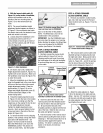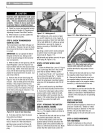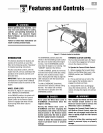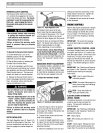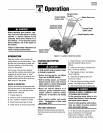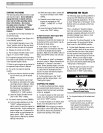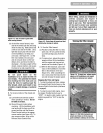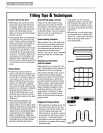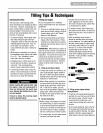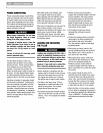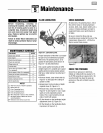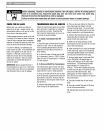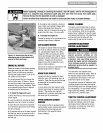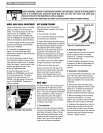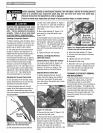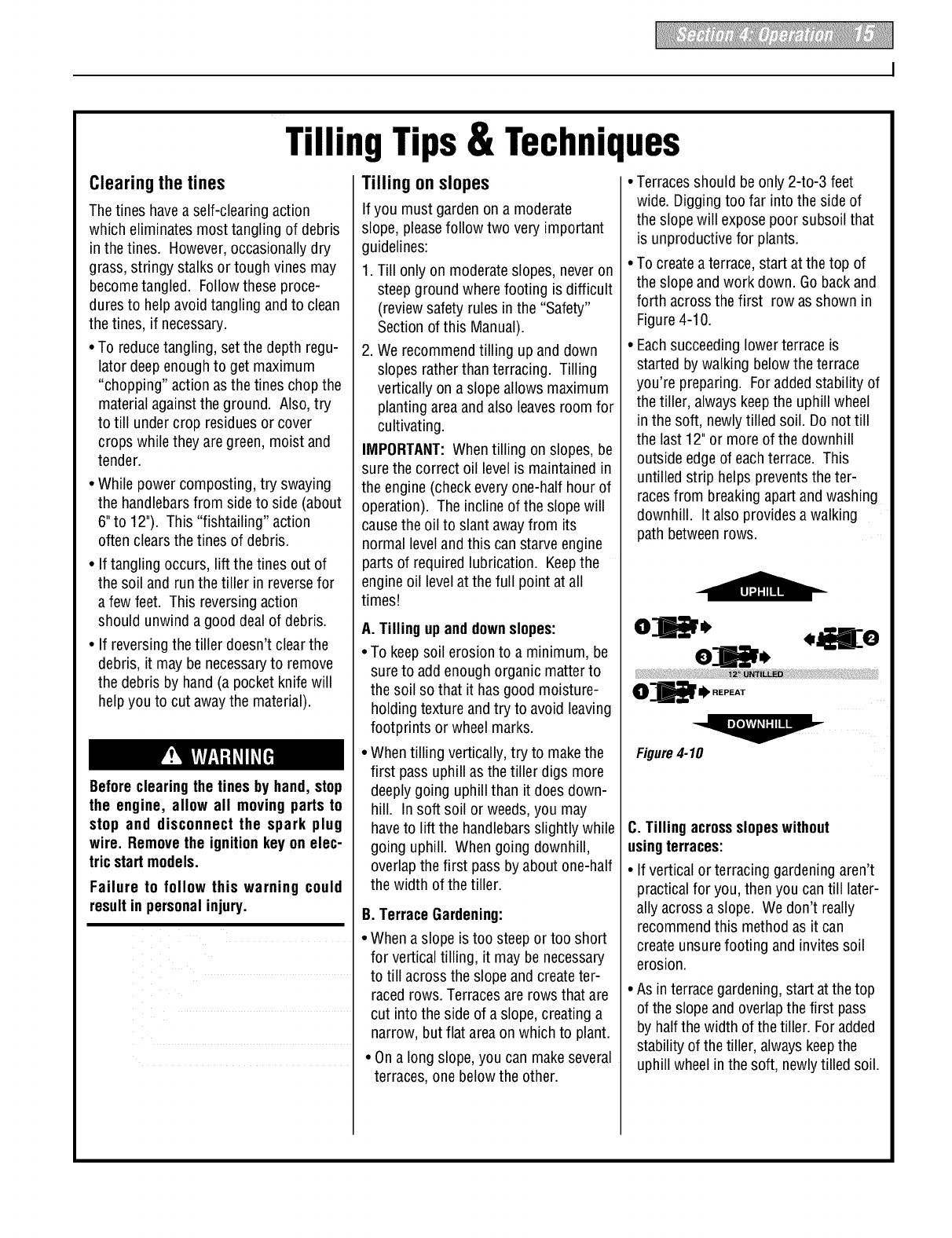
Tilling Tips & Techniques
Clearingthetines
Thetines havea self-clearing action
which eliminates most tangling of debris
in the tines. However,occasionally dry
grass, stringy stalks or tough vines may
becometangled. Followthese proce-
duresto help avoidtangling and to clean
the tines, if necessary.
• To reduce tangling, set the depth regu-
lator deepenough to get maximum
"chopping" action asthe tines chop the
materialagainst the ground. Also, try
to till under crop residuesor cover
crops while they are green, moist and
tender.
• While power composting, try swaying
the handlebarsfrom sideto side (about
6" to 12"). This "fishtailing" action
often clearsthe tines of debris.
• If tangling occurs, lift the tines out of
the soil and run the tiller in reversefor
a few feet. This reversing action
should unwind a good deal of debris.
• If reversingthe tiller doesn't clearthe
debris, it may benecessaryto remove
the debris by hand (a pocketknife will
helpyou to cut awaythe material).
Beforeclearingthe tines by hand, stop
the engine, allow all moving parts to
stop and disconnect the spark plug
wire. Removethe ignition keyon elec-
tric start models.
Failure to follow this warning could
resultin personalinjury.
Tillingon slopes
If you must garden ona moderate
slope, pleasefollow two very important
guidelines:
1.Till only on moderateslopes, never on
steep ground where footing is difficult
(reviewsafety rules inthe "Safety"
Section of this Manual).
2. We recommendtilling up and down
slopes ratherthan terracing. Tilling
vertically on a slope allows maximum
plantingarea andalso leavesroom for
cultivating.
IMPORTANT:Whentilling on slopes, be
sure thecorrect oil levelis maintained in
the engine (checkevery one-half hour of
operation). The incline of the slope will
causethe oil to slant awayfrom its
normal levelandthis canstarve engine
parts of required lubrication. Keepthe
engine oil levelatthe full point atall
times!
A. Tilling up anddownslopes:
• To keepsoil erosionto a minimum, be
sureto add enoughorganic matter to
the soil so that it hasgood moisture-
holding texture andtry to avoid leaving
footprints or wheelmarks.
• When tilling vertically, try to makethe
first pass uphill asthe tiller digs more
deeplygoing uphill than it does down-
hill. In soft soil or weeds,you may
haveto lift the handlebarsslightly while
going uphill. Whengoing downhill,
overlapthe first pass by about one-half
the width of the tiller.
B. TerraceGardening:
• When a slope is too steep or too short
for vertical tilling, it may be necessary
to till across theslope and createter-
racedrows. Terracesare rowsthat are
cut into the side of a slope, creating a
narrow, but flat areaon which to plant.
• Ona long slope, you can makeseveral
terraces, one below the other.
Terracesshould be only 2-to-3 feet
wide. Digging too far intothe side of
the slope will expose poor subsoil that
is unproductivefor plants.
To createa terrace,start at the top of
the slope and work down. Goback and
forth acrossthe first row as shown in
Figure4-10.
Eachsucceedinglower terrace is
started bywalking belowthe terrace
you're preparing. Foraddedstability of
the tiller, always keepthe uphill wheel
in the soft, newly tilled soil. Donot till
the last 12"or more ofthe downhill
outside edgeof eachterrace. This
untilled strip helps preventsthe ter-
racesfrom breakingapartand washing
downhill. It also provides a walking
path betweenrows.
, ll::e
o3mmr,
O_l_' REPEAT
Figure4-10
C. Tilling acrossslopeswithout
usingterraces:
• If vertical or terracing gardening aren't
practicalfor you, then you can till later-
ally across a slope. We don't really
recommendthis methodas it can
create unsurefooting and invites soil
erosion.
As in terracegardening,start at thetop
ofthe slopeand overlapthefirst pass
by halfthe width of the tiller. Foradded
stability of thetiller, always keepthe
uphill wheel inthe soft, newlytilled soil.



